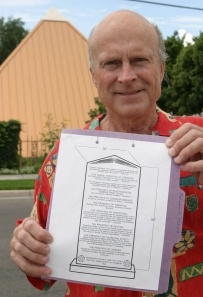c.2008 Religion News ServiceWASHINGTON _ When a city permits a Ten Commandments monument in a public park, must it then permit other monuments with a different point of view? Or does it have the right to pick and choose?The answer to those questions is what lawyers for Pleasant Grove City, Utah, and a little-known religious group called Summum will debate before the U.S. Supreme Court next Wednesday (Nov. 12).The case deals with Summum’s attempt to erect a monument to the group’s “Seven Aphorisms” alongside an already accepted Ten Commandments marker. The Denver-based 10th U.S. Circuit Court of Appeals has already ruled in Summum’s favor, saying the group had been the victim of viewpoint discrimination when the city rejected the monument.If the Supreme Court upholds the 10th Circuit decision, Summum plans to place a stone monument similar to the Ten Commandments marker given to Pleasant Grove City by the Fraternal Order of Eagles in Pioneer Park, a city park that officials say recalls the city’s Mormon pioneer heritage and contributions of local civic organizations. The park includes an artifact from the Mormon Temple in Nauvoo, Ill., as well as a Sept. 11 monument that was a Boy Scouts project.Summum is arguing its case based on free-speech rights. The larger issue, however, rests on whether a city-approved monument _ religious or otherwise _ can be considered “government speech” and therefore subject to government regulation.“Anyone who looks at it, understands that what happened here is that the city decided to dub the Ten Commandments and the other monuments `government speech’ in order to keep this group out,” said Charles Haynes, senior scholar at the First Amendment Center in Washington.“Whether they can technically get away with that is the legal argument here. The 10th Circuit is saying, `No, you can’t.” But the Supreme Court could turn around and say `Yes, you can.”’The case has drawn significant interest from municipalities, the federal government and religious liberty groups concerned about the precedent the high court could set.“It really does impact every federal park, from the Mall in Washington to Gettysburg National Military Park in Gettysburg, Pa.,” said Jay Sekulow, chief counsel of the American Center for Law and Justice, which is representing the city.“The ramifications of this are very, very broad. … The idea that you can compel a government to do this would, in essence, require the U.S. government to accept the Statue of Tyranny next to the Statue of Liberty.”In a joint amicus brief, nine cities note that Kansas pastor Fred Phelps, known for his vocal “God Hates Fags” protests, has sought to erect a monument stating that Matthew Shepard, the gay college student who was beaten to death 10 years ago, is in hell. Phelps wanted the monument in the same plaza in Ogden, Utah, that includes a Ten Commandments monument.Summum, a 33-year-old spiritual group known for its unique practice of mummification, argues in court documents that the “parade of horribles” feared by Pleasant Grove City supporters will not come to pass.“There are rules that can be adopted which would prevent certain kinds of monuments being put in city parks,” said Brian Barnard, managing attorney of the Utah Civil Rights & Liberties Foundation, and a member of the legal team representing Summum.In earlier cases when the 10th Circuit sided with Summum’s request for its monument to be placed near Ten Commandments monuments, other Utah municipalities have sold or removed the commandments instead of accepting Summum’s principles on public land. Barnard said Summum did not wish for that kind of outcome but only wanted to share its beliefs as well.K. Hollyn Hollman, general counsel for the Baptist Joint Committee for Religious Liberty, joined with other church-state groups in a friend-of-the-court brief that suggests the courts still need to decide whether such monuments violate the constitutional prohibition against a government-established religion.In 2005, the Supreme Court ruled in favor of one set of Ten Commandments displayed with other monuments outside the Texas Capitol, but ruled displays in Kentucky were unconstitutional for religious purposes.“I think it is an example of the practical problems that arise anytime the government sponsors religious displays,” Hollman said of the Summum case.(OPTIONAL TRIM FOLLOWS)The Becket Fund for Religious Liberty, meanwhile, filed a separate brief hoping that the Supreme Court won’t decide the case too broadly in favor of the city by deeming “government speech” any expression accepted by the government. The Becket Fund successfully won a case for a couple that wanted to include the words “Jesus is the cornerstone” on a brick walkway of a Chicago park.“If a rule were adopted that once it becomes property of the government that it is automatically government speech, then Chicago could come in and pull, specifically, that brick out,” said Eric Rassbach, the Becket Fund’s national litigation director. “We don’t want to end up with a rule that is like that.”KRE/JM END BANKS825 wordsFile photos of the Summum group are available via https://religionnews.com
Supreme Court to consider non-traditional monuments
c.2008 Religion News ServiceWASHINGTON _ When a city permits a Ten Commandments monument in a public park, must it then permit other monuments with a different point of view? Or does it have the right to pick and choose?The answer to those questions is what lawyers for Pleasant Grove City, Utah, and a little-known religious […]





